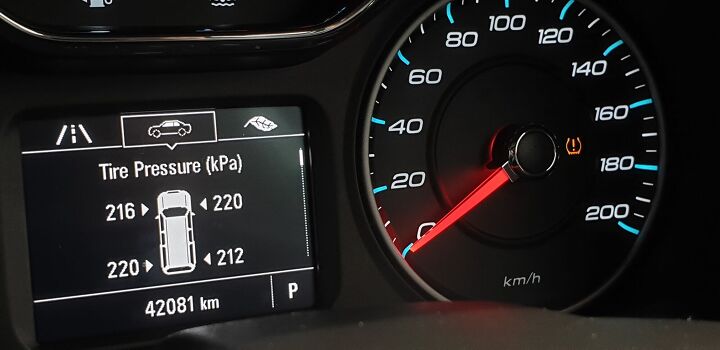Tech Q&A: Talking TPMS
Greetings Readers,
Let me start by saying thank you for the kind words I received and for welcoming me aboard! I am looking forward to this first response and all the others that I know will follow.
For my first Q&A piece, I received an email from Ron asking about TPMS's, aka “Tire Pressure Monitoring Systems.”
Thank you for sending in your email Ron.
Send your questions to this carysgarage@gmail.com, and we'll do our best to answer them.
Hi, Cary (and welcome aboard),
Quick question: why don't they make it possible to replace the battery
in a TPS sensor instead of replacing the whole thing? I think I know
the answer to this one, but you just may surprise me.
I recently had one die and the shop I go to (which usually treats me
quite well) is asking $90+ for just the sensor. That's roughly $20
more than Rock Auto's price on the OEM. Schrader has got them (again
at Rock Auto) for $22. Which reminds me of a second question.
The listings for these at Rock Auto say they are 'programmed for exact
year/make & model' and just need to go through the OEM relearning
procedure. My mechanic said they all have to be programmed. Which is
accurate?
Thanks for any 'enlightenment' you can offer.
Ron
Ron,
Let me start off by explaining that in the United States car market the Tire Pressure Monitor was required on all vehicles from September 2007 according to the “TREAD” act as a form of safety equipment on passenger vehicles.
According to the writers of this safety act, driving on a deflated tire(s) is unsafe and could cause any sort of accident, so they mandated a way to quickly be informed of a low tire situation.
Now I am sure there is a way to make the in-tire sensors have the ability to have changeable batteries, and I have seen people make videos about how to do such a process. But the plain and simple is that the sensor itself is considered a piece of safety equipment and the life of the battery is also the life of the unit itself, and because it is part of a safety system and the sensor is a wear item, they want to make sure that it works to the best of its ability.
Depending on the size of your tire the sensor can make upwards of over 6-8 million (on average) revolutions per 10k miles, and since we know the national average is 12-15k miles a year, and the life range of a sensor is expected to be anywhere between 5-12 years with an average of 7 years, you can see how that the sensor in the wheel can see a lot of movement and transmissions to the computer system.
There might be some sort of reason behind manufacturing and making money when it comes to the sensors having a sealed battery, but it’s hard to truly say and I really only know the technical aspect of the whole picture and how the system works.
As far as price and programming go, I can’t speak to the shop that is selling the parts as they are depending on their own supply source and mark-up that they decide on. Most times you will always be able to find it far cheaper online since you are taking the “middle man” aka the shop out of the picture.
By them saying “Programmed for the Exact year/model” that mainly refers to the fact that it will be able to communicate with that specific vehicle's TPMS frequency receiver, but all TPS need to be programmed to the vehicle so the computer can communicate to the unique ID of the sensor being installed and the vehicle can communicate the data to the display screen or however it indicates the tire pressure warning.
There are older vehicles that were produced with a form of TPMS that worked a bit differently than they do today, those vehicles were made far before the system was required and the operating procedures for them very well might function a bit differently. So all of the info stated above is for the modern systems that we have in vehicles today.
Thank you for the email Ron asking your question!
I look forward to more questions from all of you out there!
[Image: Tetrisme/Shutterstock.com]
Become a TTAC insider. Get the latest news, features, TTAC takes, and everything else that gets to the truth about cars first by subscribing to our newsletter.
More by Cary Hubbard
Latest Car Reviews
Read moreLatest Product Reviews
Read moreRecent Comments
- Mike Bradley Driveways, parking lots, side streets, railroad beds, etc., etc., etc. And, yes, it's not just EVs. Wait until tractor-trailers, big trucks, farm equipment, go electric.
- Cprescott Remember the days when German automakers built reliable cars? Now you'd be lucky to get 40k miles out of them before the gremlins had babies.
- Cprescott Likely a cave for Witch Barra and her minions.
- Cprescott Affordable means under significantly under $30k. I doubt that will happen. And at the first uptick in sales, the dealers will tack on $5k in extra profit.
- Analoggrotto Tell us you're vying for more Hyundai corporate favoritism without telling us. That Ioniq N test drive must have really gotten your hearts.


































Comments
Join the conversation
My 2015 Fit had no in tire sensors. Just measured wheel speed somehow to detect low pressure. Simple, cheap, effective. So of course those systems are rare.
Exactly, complexity for complexity sake.